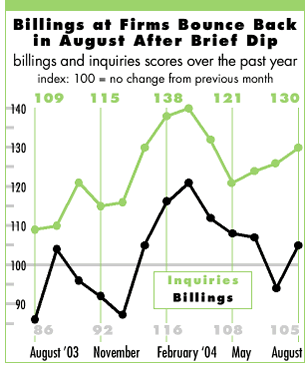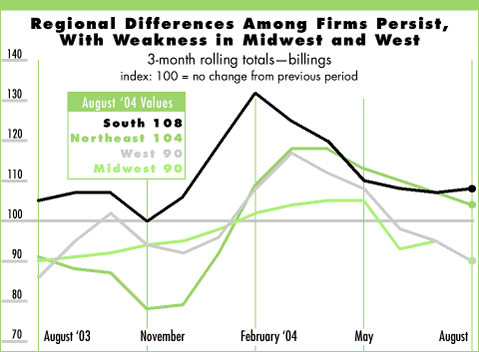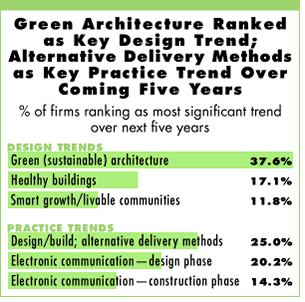

Architecture Firm Billings
Recover in August
Green architecture most significant design trend, alternative delivery
tops practice list

by Kermit Baker,
PhD, Hon. AIA
Chief Economist
 The
dip in billings at architecture firms in July looks to have been a one-month
slip, as billings reversed and advanced in August, according to our national
panel of architecture firms. It is likely that this upturn will be sustained
heading into the fall construction season for two reasons.
The
dip in billings at architecture firms in July looks to have been a one-month
slip, as billings reversed and advanced in August, according to our national
panel of architecture firms. It is likely that this upturn will be sustained
heading into the fall construction season for two reasons.
First, the modest upturn in billings was broad-based: While firms with less than a quarter million dollars in annual billings reported a modest falloff in billings in August, firms in all other revenue categories reported healthy gains. Likewise, although commercial/industrial firms fell back slightly in August, firms in all other specialization categories reported billings increases. Second, inquiries for new projects accelerated again in August and are approaching the levels we saw earlier this year. As these inquiries translate into projects, we should see billings at firms continue to grow.
While increased billings are fairly uniform across firms by size and specialization, there remain pockets of regional weakness at firms in the Midwest and West. Firms in both of these regions reported greater declines in billings in August than they had reported in July.
Broader economy sends mixed signals
In the broader economy, the Federal Reserve Board feels that the soft
patch the economy hit in the second quarter was largely due to rising
oil prices and is mostly behind us. While there are signs of an improving
economy, there also are signs of continued weakness.

Troubling indicators include the disappointing increases in payrolls, consumer sentiment levels, and leading economic indicators. While payroll gains in August surpassed those in June and July, at 144,000 they still are below the symbolic 150,000 level, the number of new jobs thought to be required to absorb new entrants to the labor force. Consumer sentiment remained at relatively low levels in September, according to the preliminary figure from the University of Michigan survey. Leading economic indicators from the Economic Cycle Research Institute declined in August for the fourth straight month, pointing to continued sluggish growth in the months ahead.
On the positive side is the continued strength in homebuilding. The August figures jumped up to the 2.0 million mark at a seasonally adjusted annual rate. To date, housing starts are running about 10 percent higher than last year’s surprisingly strong performance. Also, businesses are reporting better results. Before-tax profits at U.S. corporations increased almost 8 percent in the second quarter when annualized, after dropping slightly in the first quarter. And while higher oil prices are putting pressure on the economy, inflation still remains under control, currently rising less than 3 percent, even with the volatile food and energy elements factored in.
 Important trends
Important trends
As the nonresidential construction recovery begins to pick up momentum,
there are emerging trends that will affect the characteristics of
buildings in the coming years. We asked our panel this month to select
the most important design trend over the coming five years and the
most important practice trend over this same period.
At the top of the list for significant design trends is green (sustainable) architecture and building products. Over a third (37.6 percent) of the respondents selected this as the most important design trend from their perspective. Other trends selected by at least 10 percent of respondents were: healthy buildings/mold in buildings or homes (17.1 percent); smart growth/livable communities (11.8 percent); and building security (10.0 percent).
The top practice trend selected was design/build and other alternative delivery methods, selected by 25.0 percent of respondents. Other significant practice trends selected by 10 percent of respondents were: electronic communication by design team during design phase (20.2 percent); electronic communication during building phase (14.3 percent); expanding role of architect in design, construction, and post-construction activities (11.9 percent); practice specialty certification (10.7 percent); and outsourcing of architecture work offshore (10.1 percent).
Copyright 2004 The American Institute of Architects.
All rights reserved. Home Page ![]()
![]()
 |
||
| This month, Work-on-the-Boards survey participants are saying: • Picking up, but incoming projects are smaller than they
were a couple of years back. • Overzealous anti-growth advocates are using extreme environmentalism
and traffic concerns to constrain or eliminate growth in the Bay
Area. • Health care has gone off of the charts! • Still a nervous market!
|
||